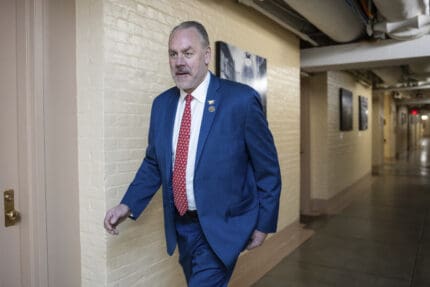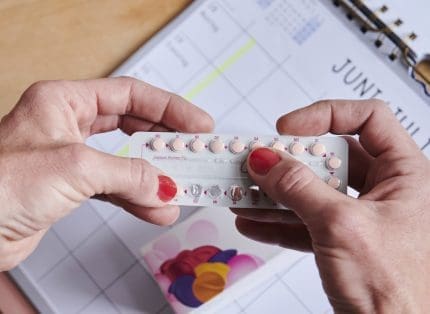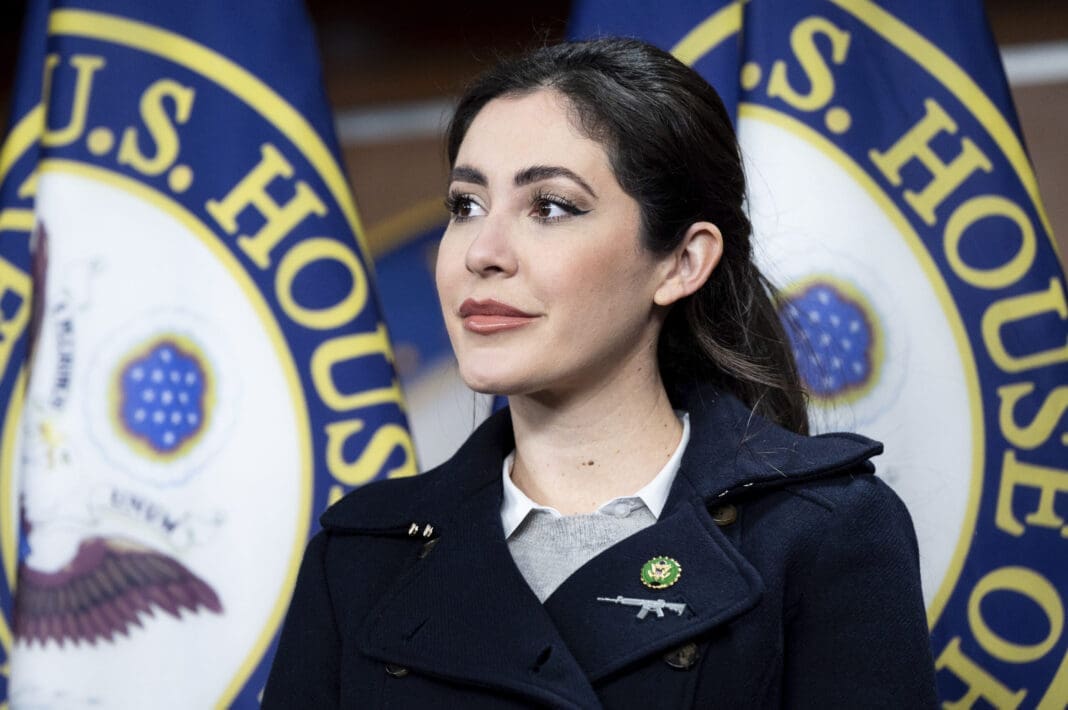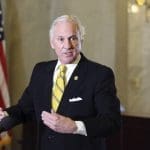Alabama artist's monument to 'Mothers of Gynecology' stands as a symbol of body autonomy
Michelle Browder’s work challenges the American health care narrative and highlights the brutality enacted on Black bodies.

This story is part of a series on the fallout of the U.S. Supreme Court’s ruling in Dobbs v. Jackson Women’s Health Organization that overturned Roe v. Wade and ended the federal constitutional right to abortion.
Two years ago, artist and activist Michelle Browder gained an outpouring of attention when her sculpture “Mothers of Gynecology” was unveiled in Montgomery, Alabama, where Browder is based.
“Mothers of Gynecology” is made up of three towering metal sculptures honoring Anarcha, Lucy, and Betsey, enslaved women who in the first half of the 19th century endured unspeakable torture when they were subjected without consent or anesthesia to medical experimentation by Dr. J. Marion Sims.
Now, Browder is using the attention on her art to address head-on the crisis of Black maternal health and reproductive justice in the United States.
Browder told the American Independent Foundation that she first learned of the women when she was in college at the Art Institute of Atlanta, Georgia. She saw on her professor’s desk a postcard of a 1952 painting by Robert Thom titled “J. Marion Sims: Gynecologic Surgeon, from ‘The History of Medicine.” The painting depicts a clothed Black woman on her knees on an examination table while three white men look on and two Black women peek out from behind a hanging sheet.
Browder said she was triggered by the image and had burning questions about the painting.
She said the woman on the table and the two women peering from behind the sheet looked afraid, as if something terrible was going to happen.
“I didn’t like that there were three white men standing around her with their hands on their hips and, you know, in a defensive stand,” Browder said. When she asked her professor about the postcard, his response was, “Figure it out.”
Browder said she began her research at the Shrine Cultural Center and Bookstore at the Shrine of the Black Madonna, a center in Atlanta specializing in the Pan-African experience. She learned about propaganda art, images created with the intention of influencing public opinion, and “medical apartheid,” the history of medical exploitation and systemic oppression of Black patients. Browder also learned about J. Marion Sims.
Sims was a slaveholder and a 19th-century American physician. He’s primarily known as the so-called father of gynecology and has been lauded for developing several pioneering gynecological procedures and a type of vaginal speculum still used today.
In the late 1840s, Sims leased Anarcha, Betsey, Lucy, and 11 other enslaved women from local plantation owners and experimented on them in an attempt to develop treatment for painful complications stemming from obstructed labor during childbirth known as fistulas, tears in the birth canal that create a hole between the bladder and the vagina through which urine continuously leaks, or between the vagina and the anus, through which feces leaks.
Sims performed surgeries on the women without ever using anesthesia, including over 30 surgeries on 18-year-old Anarcha.
In his autobiography “The Story of My Life,” Sims wrote he didn’t use anesthesia for the surgeries because “they are not painful enough to justify the trouble and risk attending their administration.”
Browder used her research to create a portfolio project at the Art Institute with sketches that would eventually be the blueprint for the “Mothers of Gynecology” sculptures. It was over 30 years before she revisited her sketches and brought the project to fruition.
Browder, now 52, began building the “Mothers of Gynecology” in 2020 during the COVID-19 pandemic. She says she was visiting friends in San Francisco when she saw a metal statue by artist Dana Albany. She reached out and asked Albany to teach her how to weld. Browder stayed in San Francisco for a month and a half to learn from Albany.
“When I came back [to Montgomery], I had half a head, half a pair of legs, and skeletons in 10 different boxes,” Browder said. Browder finished the sculptures in November 2020 and unveiled them in late February 2021.
Browder explains that the towering metal sculptures —Anarcha stands 15 feet tall, Betsey stands 12 feet tall, and Lucy stands 9 feet tall — are purposefully naked to counter the “false narrative” of Thom’s painting, in which Lucy is clothed:
If you notice their stance, they’re naked, in the original Robert Thom piece. They’re not naked. So that’s a false story or false narrative to what was really happening with these girls. They were experimented on without anesthesia. without consent — of course, they were enslaved, so of course there wouldn’t be any consent — but it’s just the mere fact that their dignity was stripped from them. So I wanted to create a piece of art that gives them dignity, respect, and identity.
Browder says it was important to her that people be forced to look up at the women.
They are each adorned with beaded necklaces. Lucy’s is in the style of the Maasai tribe. On top of the steel, Browder welded scissors, needles, cut glass, hinges, a speculum used in gynecological exams, and the names of famous Black women. Most recently, after the U.S. Supreme Court’s decision overturning Roe v. Wade in June 2022, she added a chain that hangs beneath Betsey’s vagina, connecting to Anarcha.
“I just wanted to tell the story about maternal health from where we were then to where we are today, and the trafficking that’s continued, the legacy of slavery that’s continuing to persist in our health care system today,” Browder says.
The sculptures reside on Browder’s More Up Campus in Montgomery, just a mile and a half from a bronze statue of Sims that was erected on the lawn of the Alabama State Capitol in 1939. The campus lot encompasses the “Mothers of Gynecology” Monument Park, a gift shop, and a house built in 1877 that will eventually be Browder’s offices and a place for people to come for meditation, self-care, and Black joy. There’s also a building designed to temporarily house about 15 travelers and activists visiting Montgomery. But the Campus is mainly a base from which Browder operates her More Up Tours, a company through which she guides people through the city’s long and haunting history of racism, slavery, and the Civil Rights Movement.
Browder’s work came full circle in 2021 when, through various grants and endowments, she purchased the building where Sims performed his barbaric experiments on the enslaved women.
She says its previous owners warned her there was paranormal activity in the building, but she knew immediately she wanted to buy it.
“I said I would offer a space for doulas and midwives to come and practice and provide resources for women who can’t afford it,” Browder told the previous owners of the building. “I will teach the rest of this history and the fact that these girls were raped and trafficked from breeding plantations. … I will have a teaching clinic. First-year residency students, before they go into their residency.”
The website description of the “Mothers of Gynecology Health and Wellness Museum and Clinic,” as it will be called, reads:
The space will provide hope, healing, and history to communities of uninsured women and a healing space for gynecologists, medical practitioners, doulas, and midwives to offer primary and prenatal care, consultations, programming, and assistance. The museum will teach the history of gynecology through the lenses of Anarcha, Lucy, and Betsey.
But Browder is a doer, and the buildout of the clinic and museum will take time and more money, so in the meantime, she says, she’d been looking for a medical unit. “We can’t wait. There’s urgency,” she said.
In April, Browder bought a small camper with a plan to convert it into a mobile health clinic. She has recruited a doula, a midwife, and a doctor of obstetrics and gynecology to see patients once a month in Alabama’s rural health care deserts. The mobile clinic will hit the road on May 14, 2023, in honor of Mother’s Day.
“We’re in a state of emergency,” Browder says. “Why do they call it a maternal health crisis? You can’t get health care. People are dying. Can’t do what’s right for your own safety.”
She says what’s happening today with restrictive abortion bans and government control of Black bodies echoes back to sisters Minnie Lee Relf and Mary Alice Relf who were taken to a hospital in Montgomery in the summer of 1973 when they were 14 and 12 and sterilized without their knowledge and against their wishes.
According to Relf v. Weinberger, a lawsuit filed by the Southern Poverty Law Center in 1973 on behalf of the Relf sisters, the girls were surgically sterilized as part of a federal government program that forced people on welfare to give up their reproductive rights or have their benefits taken away from them. Their mother, who could not read and write, had signed an X on a consent form, not understanding what she was signing.
“They took their reproductive organs. That’s not autonomy. They thought they were going in for contraceptives, and they left without a uterus. Can you believe that? So there’s this god complex that we’re still grappling with with Congress folks, and people who have the power to change policy are really usurping your authority,” Browder says.
Browder says she hopes people will see the connection between the history of “Mothers of Gynecology” and where we are today.
“Forced labor, forced pregnancies that they’re doing now, because basically, that’s what they’re doing, they’re forcing women, and even though I believe in the sanctity of life, I just believe that a woman should have autonomy over her body, period. So I think that with this monument, people don’t really focus on that part of the story. That this is what’s happening today. And I hope that we can talk more broadly about it,” Browder says.
Published with permission of The American Independent Foundation.
Recommended

Biden campaign launches new ad focused on Affordable Care Act
Former President Trump has said he wants to do away with the popular health care law.
By Kim Lyons, Pennsylvania Capital-Star - May 08, 2024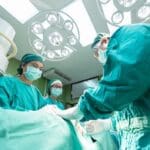
Ohio doctors fear effects of emergency abortion care case set to go before U.S. Supreme Court
A federal law that allows emergency departments to treat patients without regard to their ability to pay will be under U.S. Supreme Court scrutiny this week, and Ohio doctors are concerned about the case’s local impact on emergency abortion care.
By Susan Tebben, Ohio Capital Journal - April 23, 2024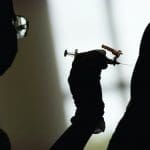
House GOP votes to end flu, whooping cough vaccine rules for foster and adoptive families
A bill to eliminate flu and whooping cough vaccine requirements for adoptive and foster families caring for babies and medically fragile kids is heading to the governor’s desk.
By Anita Wadhwani, Tennessee Lookout - March 26, 2024


















